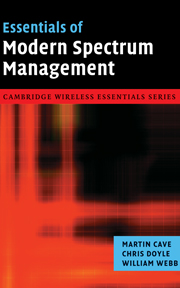Book contents
- Frontmatter
- Contents
- Acknowledgements
- I Emerging problems with the current spectrum management approach
- II Markets
- III Regulation
- 11 Incentive based spectrum prices: theory
- 12 Incentive based spectrum pricing: practicalities
- 13 How the commons works
- 14 Commons or non-commons?
- 15 Is public sector spectrum management different?
- 16 Are developing countries different?
- IV Conclusions
- Further reading
- Abbreviations
- Author biographies
- Subject index
14 - Commons or non-commons?
Published online by Cambridge University Press: 13 August 2009
- Frontmatter
- Contents
- Acknowledgements
- I Emerging problems with the current spectrum management approach
- II Markets
- III Regulation
- 11 Incentive based spectrum prices: theory
- 12 Incentive based spectrum pricing: practicalities
- 13 How the commons works
- 14 Commons or non-commons?
- 15 Is public sector spectrum management different?
- 16 Are developing countries different?
- IV Conclusions
- Further reading
- Abbreviations
- Author biographies
- Subject index
Summary
Introduction
This chapter starts by considering whether market mechanisms could be used to determine the appropriate amount of spectrum commons. It then addresses two possible approaches that the regulator might use to make this decision, namely (1) the “total spectrum needed” approach and (2) the “band-by-band” approach.
The use of market mechanisms to determine the amount of spectrum commons
The standard market mechanisms are difficult to apply directly to unlicensed spectrum. Because there is no single user body, it is not possible for the unlicensed users to directly buy the spectrum under auction or trading.
A possibility is for a third party (the “unlicensed spectrum manager”) to buy spectrum and to make it a private commons. Users wishing to access this would pay the unlicensed spectrum manager by some mechanism. The difficultly is in envisaging an appropriate mechanism. Ideally, the payment should reflect the level of usage, but for many unlicensed devices keeping account of the amount of usage and periodically returning the information would impose such a major increase in complexity and hence cost, that much of the revenue opportunity would be lost in subsidising devices. An alternative is to impose a royalty-like fee on the manufacture of each device, with the fee level coarsely reflecting the expected usage (e.g. a garage door opener would pay less than a W-LAN node). This is more plausible as similar mechanisms are used today to collect royalty payments on patents.
- Type
- Chapter
- Information
- Essentials of Modern Spectrum Management , pp. 223 - 230Publisher: Cambridge University PressPrint publication year: 2007



